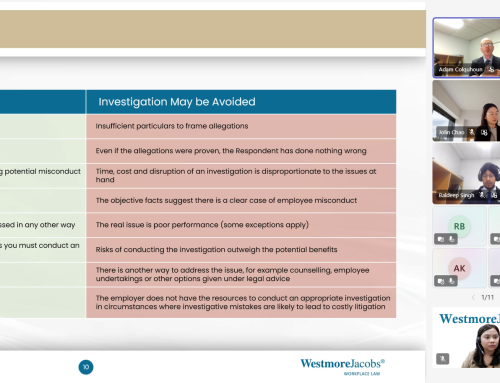
Employment law is complex and ever changing. Mistakes can easily be made, often unintentionally. Unfortunately, these mistakes can leave employers unstuck dealing with significant adverse consequences.
In this article we consider a number of cautionary tales in the area of employment law.
Contractor or employee?
For any business, correctly engaging a worker as either an employee or independent contractor is key. A worker’s status impacts on entitlements and obligations under workplace, superannuation, and tax laws.
It is well established that the question of whether a worker is an independent contractor or employee is often determined using the common law multi-factorial approach. However, the cases also demonstrate that an evaluation of the totality of the relationship between parties is not straightforward.
In Gupta v Portier Pacific Pty Ltd; Uber Australia Pty Ltd t/a Uber Eats
This decision was recently appealed to the Full Court of the Federal Court with the driver challenging the Full Bench’s finding. The Court’s transcript revealed probing questions from the Court and robust discussion into the nature of the driver’s relationship with Uber. Justice White said, amongst other things, that Uber had “drawn up this careful contract with all these provisions in it, and either does not have a view as to what is the correct characterisation of the relationship or is not willing to disclose it to this court“. The matter was resolved in private settlement, before any decision was issued (and potential precedent set).
Ultimately, each case is determined on its merits. Businesses should carefully scrutinise the nature of the relationship with their workers, at the risk of running into legal consequences down the track.
Reasonable notice
A common weakness we see in employment contracts is the failure to specify a period of notice by which the employer can end the employment relationship. Alternatively, in some situations the employee has no signed employment contract at all.
Where the contract is silent on the issue of notice (or there is no written contract) an employee whose employment has ended can bring a claim for reasonable notice at common law. This is because reasonable notice will be implied by law into employment contracts which do not have an express term dealing with notice.
Depending on factors such as the employee’s seniority and length of service, a Court may consider that up to 12 months’ notice is reasonable. If this is the case, then the business must generally pay damages equivalent to the employee’s salary for that notice period.
In the recent case of Roderick v Washington H Soul Pattinson Co Ltd (No 2) [2020] NSWSC 1224, the Court found a senior executive’s employment was not subject to a written contract following her promotion. Reasonable notice therefore applied. Taking into account the implied 12-month notice and incentive terms, Judge Cavanagh ordered compensation to be paid to the former employee, totaling $1.1 million.
The cases show that the simple omission of a correctly drafted notice term, or the absence of a signed contract, can be costly.
Incorporated policies
Another common issue we see with employment contracts is the incorporation of employment policies through references to policies in the contract. On the flip side, we also see the use of ‘contract like’ language in policies themselves. Both practices are problematic.
The issue of whether a policy is incorporated into an employment contract is an important one. It creates a risk of the policy creating binding contractual obligations on the business which employees can seek to enforce or claim damages for breach.
Contracts have been found to incorporate an employer’s policies where the employee was required in the contract to “abide by” the employer’s policies, and the policies used promissory language.[1] By contrast, a policy will generally not be incorporated if it is intended to operate as a guide only, or the contract expressly states that the policy does not form part of the employment contract.[2]
Employees may be awarded significant damages if a company breaches a policy that is contractual in nature. For example, in Goldman Sachs JBWere Services Pty Ltd v Nikolich [2007] FCAFC 120, the Court upheld damages of over $500,000, arising from the employee’s psychological injury and the employer’s failure to adhere to its own policies.
When preparing policies, employers should carefully consider the content and tone of the policy. The way the policy is referenced in any employment contract is also important.
Casual employees
Employment law challenges commonly arise when businesses have difficulty staying abreast of changes. The law around what is a casual employee is no exception.
All too often, employers blur the distinction between casual and permanent employment. This may leave the door open for employees engaged as casuals to claim permanent employment entitlements.
The significant decisions of WorkPac Pty Ltd v Skene [2018] FCAFC 131 (“Skene“) and WorkPac Pty Ltd v Rossato [2020] FCAFC 84 (“Rossato“)[3] effectively clarify that a casual employee is one who has no firm advance commitment to continuing and indefinite work according to an agreed pattern of work.
The Fair Work Amendment (Supporting Australia’s Jobs and Economic Recovery) Bill 2020 seeks to resolve some of the uncertainty with respect to casual employees and simplify casual engagement for employers. The Bill, if passed by Parliament, would introduce a statutory definition of casual employee that focuses on the offer and acceptance of employment and draws on some of the principles set out in Skene and Rossato.
Employers would be wise to keep a close eye on the Bill’s passage through Parliament and in the interim ensure (as far is practically possible) they are mindful of the legal consequences of Skene and Rossato.
Adam Colquhoun, Principal
This article is general information only. It is not legal advice. If you need legal advice, please contact us.
[1] See, for example, Riverwood International Pty Ltd v McCormick [2000] FCA 889.
[2] See, for example, Yousif v Commonwealth Bank of Australia [2010] FCAFC 8.
[3] The decision of WorkPac Pty Ltd v Rossato [2020] FCAFC 84 has been appealed to the High Court.





